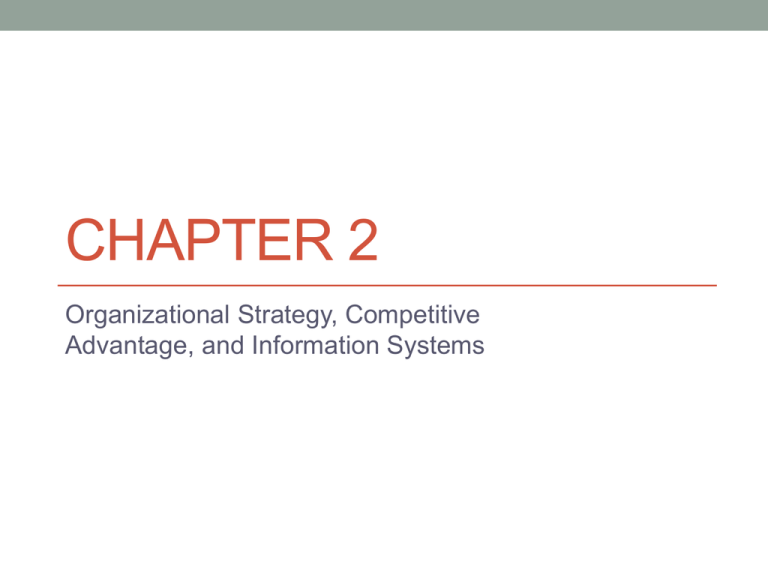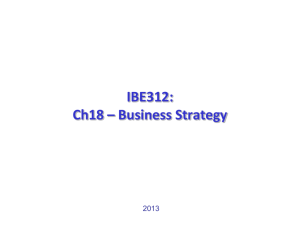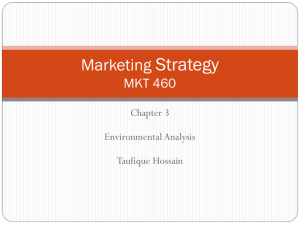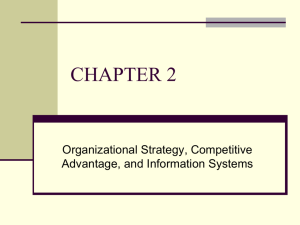Business Process
advertisement

CHAPTER 2 Organizational Strategy, Competitive Advantage, and Information Systems Strategy! A high level plan to achieve a goal under conditions of uncertainty.(Wikipedia) • A desired outcome • Gaining market share • Outperform competitors • Cost, quality and time to market Chapter 2- Corporate Strategy • Business Process• Pressures • Responses • Global Flatteners Examine Value Chain Model Business Processes • Business Process- related activities that produce a product or a service of value to the organization, its business partners/ and or customers Examples of Business Process • Accounts Collection • After Sale follow-up • Managing packing, storage, and distribution Business Process Management • Business process management is a management technique that includes methods and tools to support the design, analysis, implementation, management, and optimization of business processes. • Optimize • Manufacturing and logistics process • Marketing and innovation • Individual work Business Process Re-engineering (BPR) • BPR is a radical redesign that improved efficiency and effectiveness • BPM is less radical, less disruptive, and more incremental • Effectiveness versus Efficiency what is the difference? Effectiveness vs Efficiency Effectiveness Efficiency Meaning: Efficiency is about doing things in an Effectiveness is about doing the right optimal way, for example doing it the task, completing activities and achieving fastest or in the least expensive way. It goals. could be the wrong thing, but it was done optimally. Effort oriented: No Yes Process Oriented: No Yes Goal oriented: Yes Yes Time oriented: No Yes Business Pressures, Organizational Responses, and IT Support Business Pressures Market Pressures Technology Pressures Societal Pressures Market Pressures The Global Economy and Strong Competition The Changing Nature of the Workforce Powerful Customers Technology Pressures Technological Innovation and Obsolescence Information Overload Technological Innovation and Obsolescence Obsolescence: Slide Rule Innovation: Early calculator Technological Innovation and Obsolescence (continued) Innovation: Telegraph Obsolescence: Pony Express Technological Innovation and Obsolescence (continued) Obsolescence: old analog camera Innovation: digital camera Technological Innovation and Obsolescence (continued) Obsolescence: Horse and Buggy Innovation: Ford Model T Information Overload Societal/Political/Legal • Social Responsibility • Manufacturing sustainability • Distribution • Humane working conditions • Government Regulations • Protection Against Terrorist Attacks • Ethical Issues Social Responsibility (continued) Bridging the Digital Divide Social Responsibility (continued) One Laptop per Child initiative Porter’s Competitive Forces Model The best-known framework for analyzing competitiveness is Michael Porter’s competitive forces model (Porter, 1985). Michael Porter Porter’s Competitive Forces Model Porter’s Competitive Forces Model • Threat of entry of new competitors is high when it is easy to enter a market and low when significant barriers to entry exist. • A barrier to entry is a product or service feature that customers expect from organizations in a certain industry. • For most organizations, the Internet increases the threat that new competitors will enter a market. Porter’s Competitive Forces Model • The bargaining power of suppliers is high when buyers have few choices and low when buyers have many choices. • Internet impact is mixed. Buyers can find alternative suppliers and compare prices more easily, reducing power of suppliers. • On the other hand, as companies use the Internet to integrate their supply chains, suppliers can lock in customers. Porter’s Competitive Forces Model • The bargaining power of buyers is high when buyers have many choices and low when buyers have few choices. • Internet increases buyers’ access to information, increasing buyer power. • Internet reduces switching costs, which are the costs, in money and time, to buy elsewhere. This also increases buyer power. Porter’s Competitive Forces Model • The threat of substitute products or services is high when there are many substitutes for an organization’s products or services and low where there are few substitutes. • Information-based industries are in the greatest danger from this threat (e.g., music, books, software). The Internet can convey digital information quickly and efficiently. Porter’s Competitive Forces Model • The rivalry among firms in an industry is high when there is fierce competition and low when there is not. 2.4 Competitive Advantage Strategies for Competitive Advantage Cost Leadership Differentiation Innovation Operational Effectiveness Customer-orientation Strategies for Competitive Advantage Figure 2.5 Porter’s Value Chain Model This model identifies specific activities where organizations can use competitive strategies for greatest impact. Primary activities Support activities Primary Activities 1. 2. 3. 4. 5. Inbound logistics Operations Outbound logistics Marketing and Sales Customer service Support Activities Accounting, Finance, Management 2. Human Resources 3. Product and technology development 4. Procurement 1. Porter’s Value Chain Model Business Pressures, Organizational Responses, and IT Support Organizational Responses • ERP • Fulfillment Automation • Ecommerce • CRM Organizational Responses • Collaborative Workflow software • Intranet • On-Demand, Mass customization • Strategic Systems a. Dashboards b. Business Intelligence c. Expert Systems




![[5] James William Porter The third member of the Kentucky trio was](http://s3.studylib.net/store/data/007720435_2-b7ae8b469a9e5e8e28988eb9f13b60e3-300x300.png)
